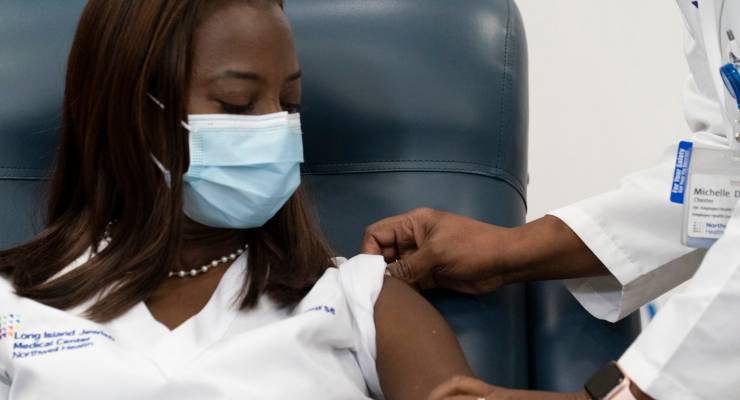
It was only a matter of time before party politics infiltrated the COVID-19 vaccination plan in Australia. The calls to speed up the vaccine rollout have resulted in the program being brought forward by a month.
But the government and our regulatory bodies would have been justified in sticking to the original timeline. The situation here is quite different to North America and Europe, and that additional time could be used to plan a more efficient rollout.
Regulators in the US, UK and Europe have had little choice but to grant emergency approval for the first vaccines. This means vaccinations can commence immediately with further testing, quality controls and interrogation of data occurring in parallel.
With daily new cases in the tens of thousands and rising exponentially, the risks of delay far outweigh the risks of fast approval. So much so that the UK is experimenting with delaying the second dose of the Pfizer/BioNTech vaccine in order to immunise more people faster.
Australia’s case numbers are currently in single or double digits. It makes no sense to start injecting a new compound into millions of otherwise healthy people without the normal safeguards by the Therapeutic Goods Administration (TGA) – a globally respected regulatory authority — all for the sake of two summer months.
TGA Advisory Committee on Vaccines chair Allen Cheng lays out very well what the TGA is doing and the dangers of skipping these safeguards.
We are well placed to take things more slowly, eliminate more uncertainties and risks, and plan a safe and efficient national immunisation.
Trust in this and future vaccines is paramount, and nothing will undermine public trust more than even a handful of well-publicised adverse reactions to the vaccine. Scepticism circulating in the community should not be underestimated and is a risk that the final checks seek to eliminate.
Immunising a country like Australia quickly will be complex. It will requires unprecedented coordination between the three tiers of government, and it poses major logistical challenges for our health information infrastructure.
The additional time would allow authorities to prepare a fast and efficient rollout. There’s a lot to do. The public need to be educated about how the vaccine will be rolled out (including the fact that immunisation is not the silver bullet that will enable life to return to pre-COVID normal). Tracking systems also need to be improved. Local outbreaks need to be avoided and subdued where necessary as these will distract authorities and healthcare workers from implementing the vaccination plan.
Thursday’s announcement that the states will decide if the vaccine should be mandatory for aged care workers was a worrying sign. Given that aged care is a Commonwealth responsibility, it seems bizarre that the federal government handballed this issue to the states.
Federal and state government should be discussing the best way to ensure that all workers who have contact with the most vulnerable parts of the population are immunised.
The best incentive, of course, is a safe, effective vaccine. But explicit inducements should also be on the table. Given that aged care workers are among the lowest paid, a one-off payment to be immunised is an option that is likely to be effective and equitable.
This is the type of planning that governments should be doing with the additional time that good public health management — and a fair amount of luck — has given us.








This is the bit I feel people miss. It’s not where you start that’s important, it’s where you finish. Yes, things are under control now, but in the face of changing seasons and new mutations, we cannot be certain that things will remain so.
Starting two months earlier is not saving two summer months – it’s avoiding two *winter* months, right when we know the virus is at its most virulent. Just look at Europe, they had a charmed summer and then straight back into pandemic as soon as the temperatures dropped.
I was supposed to go to Houston last September to set up a sales and distribution network for a specialised machine tool that I have developed.
The pandemic made that impossible and with the recession it induced unnecessary.
Many airlines have delayed international flights well into 2021, but have also stipulated no jab-no fly rules as well.
The current restrictions against issuing exit visas to nationals will remain in force until people can get vaccinated.
Right now, people involved with quarantine hotels, and people wishing/needing to depart to high risk countries need to be vaccinated.
Just be aware that the vaccines do not stop the spread, only the severe illness. There are very few countries safe to travel to, certainly not the US, UK or Europe for the most part. We know little about the effects of the vaccine over a population.
It’s not true to say that Covid vaccines do not stop the spread. Every vaccine has some sterilising effect, it’s fully expected that the Covid ones will as well, but as it hasn’t been studied, we don’t know to what degree.
I think we need to realise the at vaccination is an illness repventer, not a spread preventer. (most are not). It may be that it lowers the degree of viral shedding enough to reduce the risk, we do not know. It is more likely to reduce the infectious period. It will require a very high level of vaccination, maybe 80% or more. IN the meantime we need to keep up with mitigation measures.
What’s 80% of 7-8 billion ?..a long time…I’ve read a little about the history of pandemics..Some talk in centuries..Of course we’re a real fast paced mammalian primate with jack be nimble jack be quick opposable thumbs these days..
If it’s ok with you OGO, I’ll take Professor Tony Blakely’s opinion on the efficacy of the vaccine, which is that generally they DO prevent you from becoming infectious (shedding virus) and his professional guess is that this vaccine will do the same. But we don’t know yet.
Given the risk associated with the quarantine hotels I think it is crazy that vaccines are not being offered to all the people coming into close contact with possibly infected people. Sure, other high risk people, like aged care workers, old people, imuno-compromised people, and so on might get a degree of greater certainty about the safety of the vaccines by waiting on the much depleted resources of the TGA to catch up with the rest of the world, but every time the virus escapes from a quarantine hotel this country faces the prospect of competing with the UK, USA, France et al for being amongst the worst examples of how to deal with the Covid19. So far we have been incredibly lucky, how long will that luck last?
I think the plan is to give the vaccine first to all those people coming in contact with returned travellers. When it is approved and available.
I did not think there has been any pressure from any politician to speed up the roll out of the vaccine by having short cuts in the verification processes.
We are lucky that CSL have already been manufacturing the Astra Zeneca vaccine (even that was delayed when the Govt was slow signing up agreements (October) – They cannot make the Pfizer vaccine so that vaccine supply relies on imports and where in the queue Australia is after Australia was slow off the mark making orders.
I understand to obtain 80% vaccination by October is impossible. Both these vaccines need two injections, so even at a rate of 100,000 + per day every day the target cannot be meet this side of Christmas,
The criticism is that the Government has not paid early enough attention to the logistics of the roll out. They will need to enlist GP practices as well as Public run facilities throughout the country.
There is no ‘cover’ from the vaccines until about 28 days after the second injection, so those with completed vaccinations that started before the end of March will be the only ones with ‘cover’ by the beginning of Winter (June).
That will be the best that can be done with an orderly approval process which will only see the Astra Zeneca ready for distribution in March
We do not get the first delivery (of whatever small amount our late contract gives us) of the Pfizer Vaccine until two weeks after approval (at the end of January) and then there needs to be a week of batch testing. The batch testing and distribution for the Astra Zeneca vaccine should be able to be done simultaneously with its February approval and will depend on how far advanced CSL is with the manufacturing, started at the end of last year.
The Govt would need to have the national electronic data base of documentation of tracking of vaccinations given and COVID testing done so that people can be certified enough to be able to start moving again.